 Aruna D’Souza
Aruna D’Souza
The artist’s new exhibition explores freedom, confinement, and
flight in the Black imaginary.
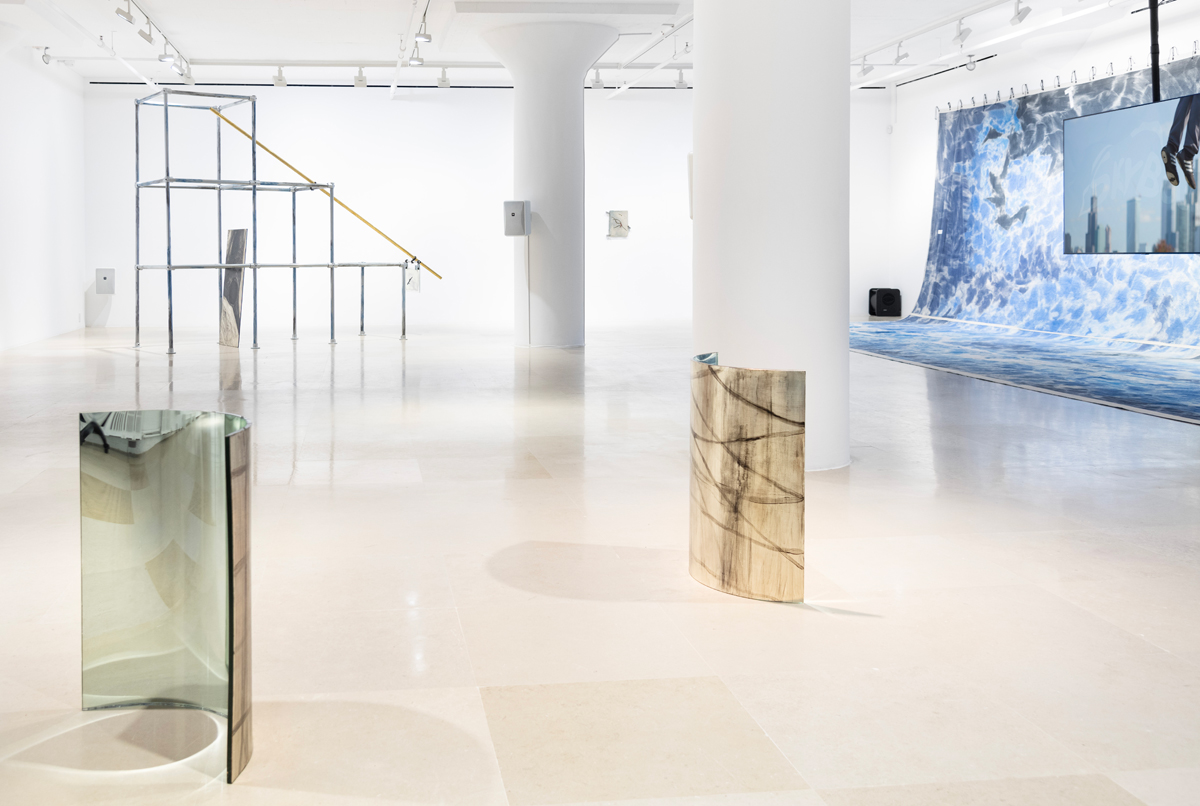
Steffani Jemison: Bound, installation view. Courtesy the artist and Greene Naftali. Photo: Zeshan Ahmed.
Steffani Jemison: Bound, Greene Naftali, 508 West Twenty-Sixth Street, New York City, through March 9, 2024
• • •
The centerpiece of Steffani Jemison’s exhibition at Greene Naftali is her new, twenty-minute video, Bound (2024). It is slow, almost meditative, in its pacing, and initially there’s not much to see: an expanse of sky, white clouds flitting across the screen, the occasional trail of a plane ascending, all as if viewed through a scrim printed with a logo that reads “SkyBound.” That logo happens to be the brand of the largest trampoline company in the US, and its name points to the dialectical tension that runs through the show—a both/and condition revolving around the potential of Black bodies to leap and soar despite the ways that gravity and other, less natural forces keep them tethered.
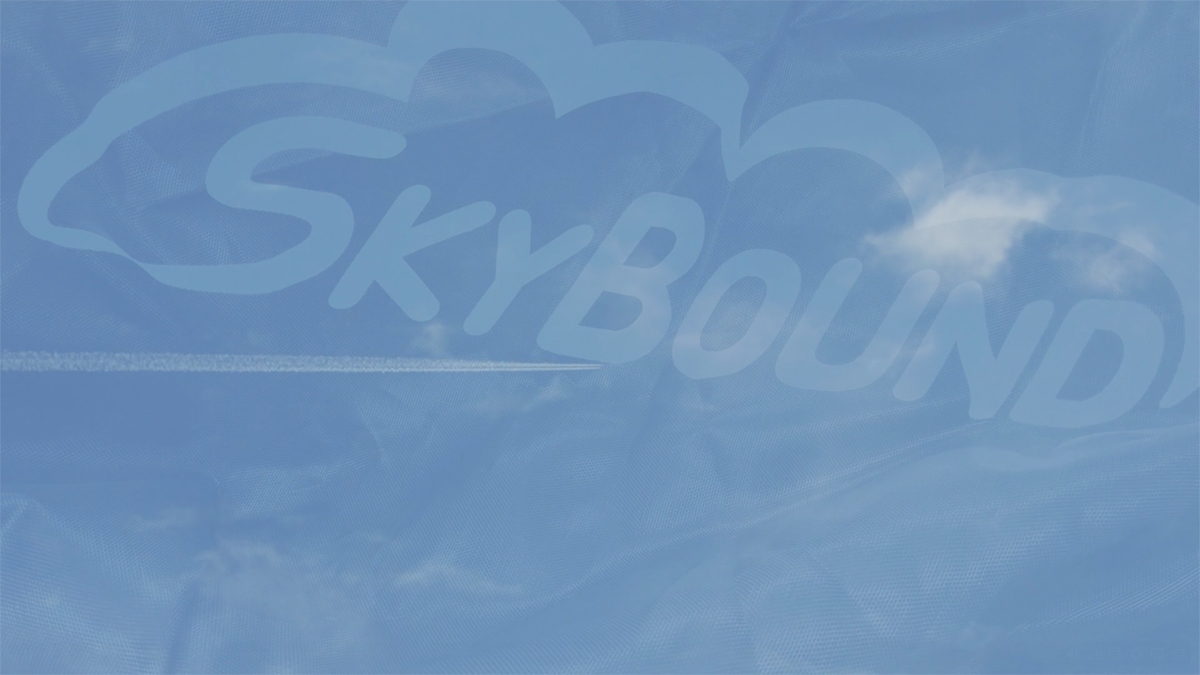
Steffani Jemison, Bound, 2024 (still). HD video, color, sound, 20 minutes 22 seconds. Courtesy the artist and Greene Naftali. Photo: Zeshan Ahmed.
Eventually, a narration begins: we hear the voice of Rayquan Minor and then, after an interlude, that of Shadiya Ewing, both members of a Chicago youth acrobatic organization, the Jesse White Tumbling Team, according to the credits on the checklist. (The storied group, established in 1959, has spawned a whole ecosystem of Black gymnastic troupes in the city over the decades, including the Chicago Boyz, who appear in the video.) At first, Minor and Ewing seem to be describing what it feels like to somersault through space, but after a few moments it becomes clear that they are not simply talking about acrobatics—they are imagining taking flight. Minor alludes to the safety flying affords: “The wind is not harsh, no bugs up there. The sun feel good and I got my sweater just in case the wind it gets too cold. So I feel real good just to, swoop and glide. I feel real safe. I feel like can’t nothing touch me. I’m not too high to where a . . . plane can get me and I’m not too low to where a . . . tree can scratch me.” Ewing dreams of escaping both her mother’s surveillance and her body’s limitations: “I’m usually cold, I’m anemic—so like, the wind and everything it just, everything was okay.” (I suggest picking up an audio transcription from the gallery desk—the installation’s sound is slightly muddy, and you don’t want to miss the real sweetness in these teenagers’ words.)
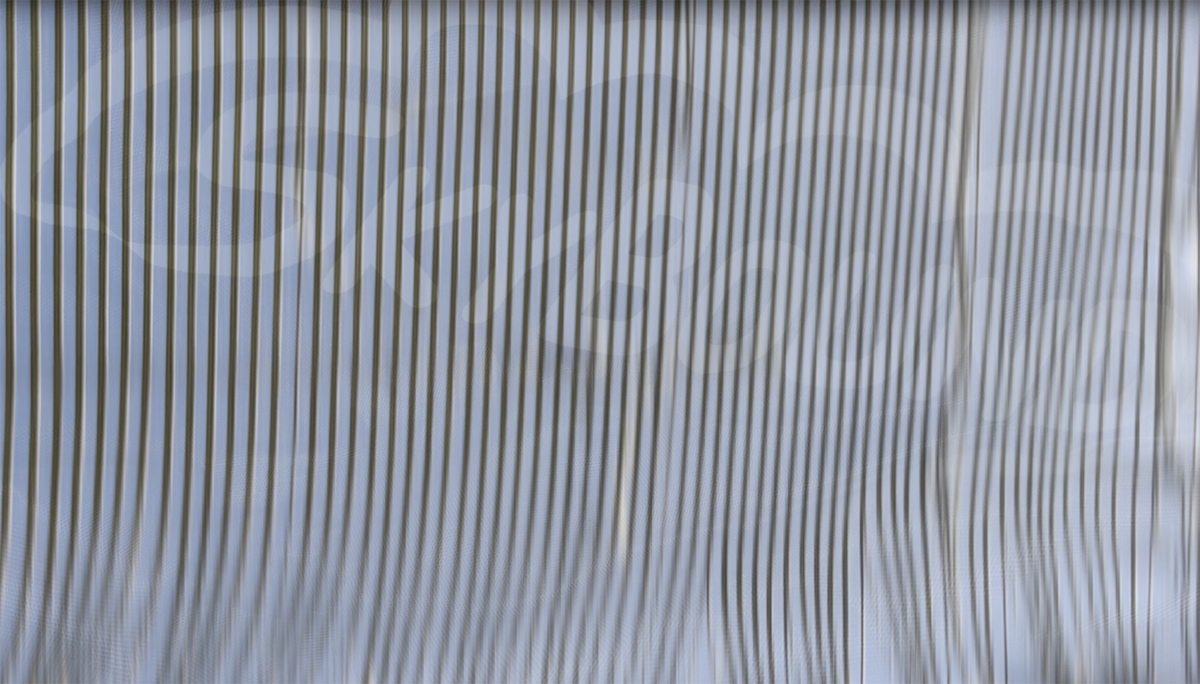
Steffani Jemison, Bound, 2024 (still). HD video, color, sound, 20 minutes 22 seconds. Courtesy the artist and Greene Naftali. Photo: Zeshan Ahmed.
Between the two voice-overs, we are presented with something other than sky: first, the striations of a trampoline shot from below and then the jarring thumps of bodies bouncing onto it and leaping into the beyond. From our viewpoint, the gymnasts seem to launch straight into the screen. After more shots of the sky—daylight blue and nighttime black—the camera shifts to a horizontal axis, with the Chicago skyline in the distance and figures in profile. Now, after a tense sonic buildup in the soundtrack—drums played by Brandon “Buz” Donald—the gymnasts vault off the unseen trampoline into the air. We never witness them land; they disappear into a flash of white synchronized to a crash of cymbals, a flourish familiar to anyone who’s been to the circus. The soundtrack is complex here: the joyful chatter of children cheering each other on, Donald’s percussion, and then, contradictorily, given the kind of corporeal freedom we’ve heard described and seen enacted, the Nelly Furtado chorus from Flo Rida’s 2009 “Jump”: “When I say jump, you say how high”—a dissonant reminder of the powers that keep us, well, bound.
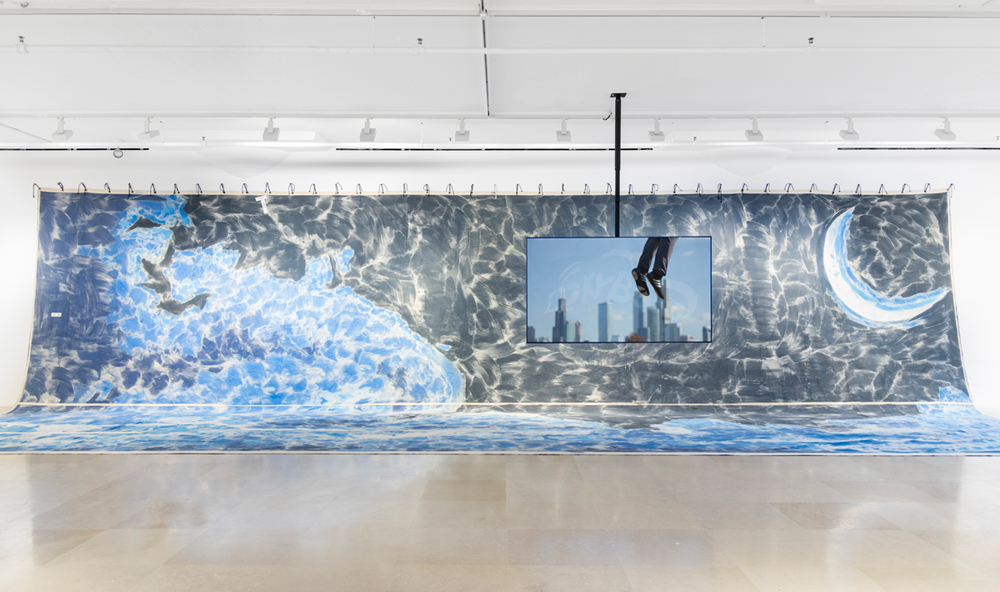
Steffani Jemison, Same Time, 2024. Decommissioned canvas backdrop, HD video, color, sound. Courtesy the artist and Greene Naftali. Photo: Zeshan Ahmed.
There are two crucial references that underpin the show: the myth of the “flying African,” on the one hand, and the Greek myth of Icarus, on the other. The former is an account, passed down through generations of African Americans, of the super-heroic power of their forbears, who, before being taken into slavery, were able to soar through the air. The tale linked the possibility of escape from bondage—and even of returning to a place of origin, a reversal of the Middle Passage—to regaining that lost ability. The story wended its way from Gullah folklore into African American spirituals; the literature of Toni Morrison, Ralph Ellison, Paule Marshall, and Octavia Butler; and children’s bedtime stories, including a celebrated book by Virginia Hamilton: “They say the people could fly. Say that long ago in Africa, some of the people knew magic. And they would walk up on the air like climbin’ up on a gate. And they flew like blackbirds over the fields. Black, shiny wings flappin’ against the blue up there.”

Steffani Jemison: Bound, installation view. Courtesy the artist and Greene Naftali. Photo: Zeshan Ahmed. Pictured, left: Untitled (Projection), 2024. Galvanized steel, brass pole, metal hardware, found silvered glass, and acrylic. Right: Untitled (Bound), 2024. Found silvered glass, metal hardware, and acrylic.
If the video foregrounds the flying African, in the rest of the gallery, Icarus takes a central role. While his story is often recounted as a warning against hubris—Icarus was arrogant to think he could defy the natural forces of gravity and the gods at once—here, as with the African American myth, the focus is on his aspiration and his quest for freedom: Icarus and his father, Daedalus, were attempting to flee imprisonment, and for all the focus on his fall, Icarus, for a few wonderful moments, also flew. He appears, in his entirety or synecdochically, in a series of paintings (all from 2024, all named Untitled [Bound]) made with acrylic paint on found glass that has been mirrored, creating a reflective effect, such that the brushstrokes seem to hover in an indeterminate space. Some are hung on the wall, others stand on the floor, and yet others are mounted on two sculptures (Untitled [Projection]), scaffolds of galvanized steel and brass poles that nod to both the jungle gym and the hidden apparatus of a theater. The jagged stars in one of these paintings seem to be pulled from the background of Henri Matisse’s iconic cut-paper portrayal of the Greek character from his 1947 book Jazz, while the glyph-like figure in another quotes Pablo Picasso’s stage designs for Serge Lifar’s 1962 ballet Icar for the Paris Opéra. The allusions to theater and stagecraft recur in a decommissioned canvas backdrop depicting a roughly sketched sky that the artist has mounted in reverse on the wall behind the video screen. (The artist has a long-standing interest in Black theaters, both as historical sites of invention and as contemporary ruins.)
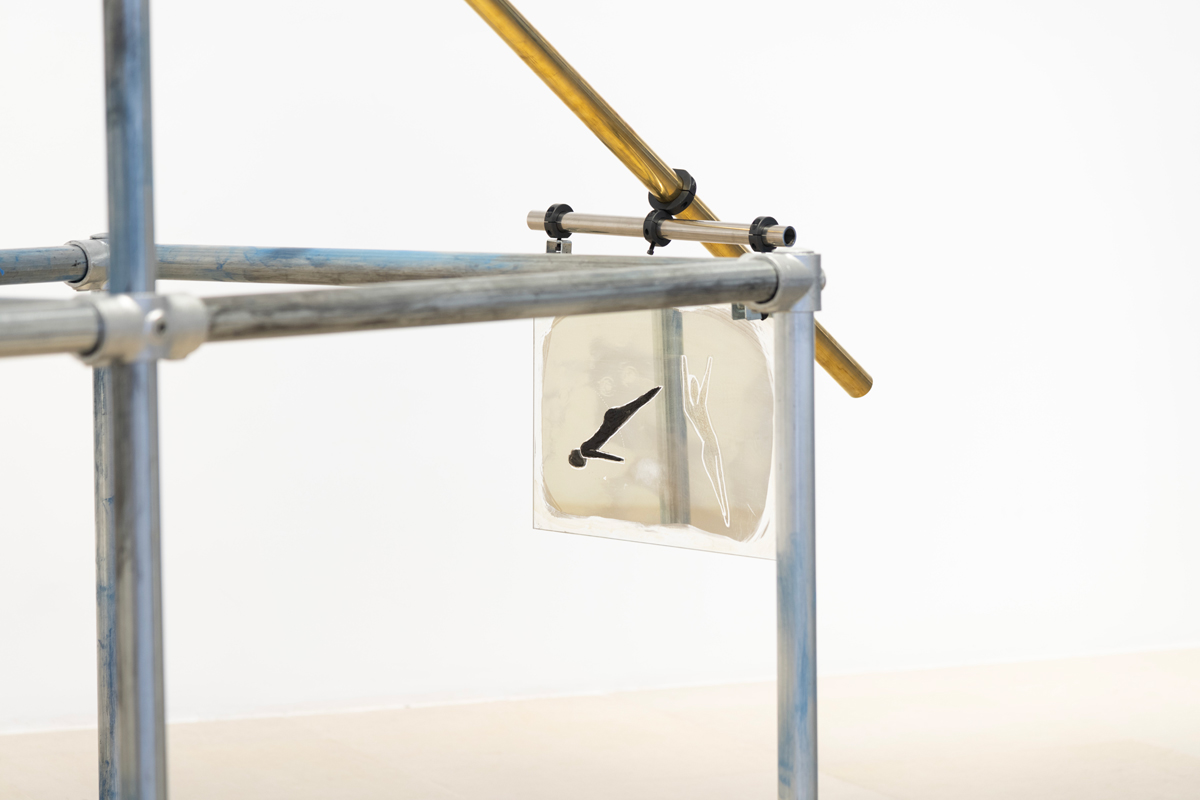
Steffani Jemison, Untitled (Projection), 2024 (detail). Galvanized steel, brass pole, metal hardware, found silvered glass, and acrylic. Courtesy the artist and Greene Naftali. Photo: Zeshan Ahmed.
Like much of Jemison’s earlier work, Bound (both the video and the exhibition as a whole) explores the ways that Black folks have survived by transforming the limitations placed on them into extraordinary and creative physical feats—or, perhaps, it plays with the idea that such extraordinary and creative physical feats might have their origins in Black survival. (Her 2010–11 Escaped Lunatic, for example, is structured as a chase scene, with the role of the fugitive enacted by members of a parkour team, suggesting that the gravity-defying art form may have emerged from a history of Black men being pursued by police, or at least insistently aligning the two phenomena.) The teenagers in Jemison’s new video—mostly, as the Chicago Boyz website points out, “inner city youth,” living in Black neighborhoods drained of educational and other resources, and strangled of opportunity as a result—are bound, held in place. But thanks to their athletic skills, their imaginations, and the artist’s canny formal strategies, we can see them reclaim their ancestral legacy—they are allowed, at least momentarily, to escape, to take flight, to find freedom.
Aruna D’Souza is a writer and critic based in New York. She contributes to the New York Times and 4Columns. Her new book, on the treachery of emotions, will be published by Floating Opera Press this spring.